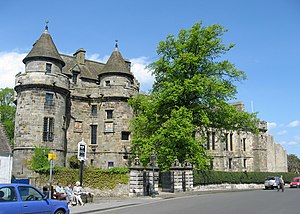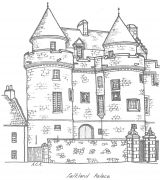Falkland Palace
| Building summary | |
|---|---|
 View from the High Street View from the High Street
| |
| Name | Falkland Palace |
| Address | High Street, Falkland |
| Postcode | KY15 7BY |
| Date | 15th century |
| Architect | John Kinross et al. |
| See maps | Map T (1), Map D (32) |
| OS grid ref | NO 25344 07454 |
| Latitude & longitude | 56°15'13"N 3°12'23"W |
Falkland Palace is a former palace of the Kings and Queens of Scotland in Falkland High Street. Parts of the palace (the South Range and the Cross House) form a Category A listed Building. The remainder of the palace (excludng the Royal Stables and Real Tennis Court) constitutes a Scheduled Monument.
This entry to be further expanded.
| HES listing details[1] | ||
|---|---|---|
| Reference:
LB8798 (as listed bulding; also SM854 as scheduled monument) |
Date:
01/02/1972; amended 27/06/2017 |
Category:
A |
| Address/Site Name
South Range of Falkland Palace including adjoining gatehouse to west and Cross House within east range, and excluding scheduled monument SM854, Falkland Palace, Falkland | ||
| Description
The present palace was begun by James II. In the 16th century the Bethunes of Creich became hereditary keepers, the keepership passing by marriage to David Viscount Murray of Stormont who built a house on the site of the original castle early in the 17th century, long ago demolished; the keepership passed from the Murrays to the Earl of Atholl during the Commonwealth; and thence to the Dukes of Atholl; acquired 1787 by Skene of Pitlour, and thence by marriage to the Moncrieffs of the Myres; in 1820 General George Moncrieff disposed of it to Professor John Bruce whose niece brought it to O Tyndall Bruce who repaired the much neglected south quarter and gatehouse in 1840; acquired from the Bruces 1887 by the 3rd Marquess of Bute: to Lord Ninian Crichton Stuart 1900, to Major Michael Crichton Stuart 1915; National Trust Deputy Keeper 1952. [...] | ||
| Statement of special interest
Items 1-8 and 10-13 and 16B group with items 1-104 in Falkland Burgh. SCHEDULED MONUMENT. [...] | ||
Cross House
The Cross House or Croce House (not to be confused with Cross House in Falkland High Street) adjoins the ruined East Range. It was built in 1529–92 and restored by John Kinross in the 1890s.[2]
- "The cross-house's first-floor room was fitted up as the King's bedroom in 1956 by W. Schomberg Scott, the walls and ceiling painted (by David McClure) in a parody of early C17 work."[3]
Former residents
Further references
"C16 early Renaissance showpiece created by James IV and James VI. In 1723 John Macky thought its courtyard 'the beautifullest Piece of Architecture in Britain. [...]"[4]
"A cluster of gems; difficult to categorise. Some say it is Gothic/Baronial/Palladian, others say Franco-Scottish with Italianate overtones. [...][5]
"During the great witch-panic of 1597, James VI and the privy council convened at Falkland palace, where, among other things, on 12 August a general proclamation was issued revoking some of the commissions of justiciary that had been granted against suspected witches on the bogus evidence of another accused witch Margaret Aitken, known as great witch of Balwearie, who claimed that she could detect other witches just by looking at their eyes; she was found to be a fraud."[6] [...]
During the national panic of 1661-2, a few women from Falkland were accused as witches. These include Margaret Garvie, Barbara Honeyman and Margaret Dryburgh. Garvie and Honeyman were imprisoned after being accused of witchcraft in December 1661. They petitioned the privy council to be released from prison in January 1662. They did not confess to witchcraft, but they had been pricked by John Kincaid, who alleged to have found some marks upon them. Both Garvie and Honeyman denied any knowledge of the marks. Both claimed that, if released, they would cooperate if a trial was pursued against them. The privy council ordered the advocate and stewards of Fife to release them from prison upon this condition.[7] No record of a commission to hold a trial exists. However, a commission to hold a trial against Margaret Dryburgh was requested at the end of January. It stated in the request for a commission that Dryburgh had confessed sometime previously.[8]
See also The Survey of Scottish Witchcraft by Julian Goodare, Lauren Martin, Joyce Miller and Louise Yeoman. The online map lists five witches associated with Falkland 1661/1662, but Garvie/Carvie and Honeyman/Horniman may be the same people
Notes
- ↑ For the full listing description, see http://portal.historicenvironment.scot/designation/LB8798
- ↑ Gifford, Fife, page 215.
- ↑ Gifford, Fife, page 216.
- ↑ Gifford, Fife, page 212. The full entry continues for five more pages, including a second-floor plan.
- ↑ Pride, Kingdom of Fife, page 85. The full entry continues to the end of page 86.
- ↑ National Trust for Scotland,Histories of the Witch Trials: The connections of NTS properties to Witch Trials, 1563–1736, page 27. (See Louise Yeoman, ‘The woman who stood up to a witch-hunt’, for a popular and accessible piece on this unusual and fascinating trial.
- ↑ RPC (Register of the Privy Council of Scotland), 3rd series, vol. i (1908), 152. Quoted in the NTS article, page 28; see also R. Chambers, Domestic Annals of Scotland: From the Reformation to the Revolution 3 vols (Edinburgh, 1858–61), ii, 279.
- ↑ RPC, 3rd series, vol. i (1908), 142-3. Quoted in the NTS article, page 28.
Further images
Drawing by A.K.C from A Falkland Guide


